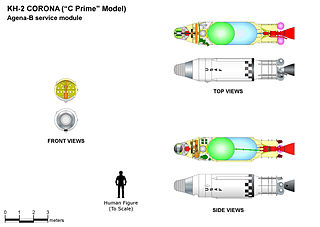
Discoverer 25, also known as Corona 9017, was an American optical reconnaissance satellite which was launched in 1961. It was the fifth of ten Corona KH-2 satellites, based on the Agena-B.
Discoverer 23, also known as KH-5 9016A, was a USAF photographic reconnaissance satellite under the supervision of the National Reconnaissance Office (NRO) which was launched in 1961. It was a KH-5 ARGON satellite, based on an Agena-B. It was the second KH-5 mission to be launched, and the second to end in failure.
Discoverer 24, also known as Corona 9018A, was an American area survey optical reconnaissance satellite which was launched in 1961 but failed to achieve orbit. It was a KH-5 Argon satellite, based on an Agena-B. It was the third KH-5 to be launched.
Discoverer 27, also known as Corona 9020A, was an American area survey optical reconnaissance satellite launched in 1961, but which failed to achieve orbit. It was a KH-5 Argon satellite, based on an Agena-B. It was the fourth KH-5 to be launched, the second consecutive KH-5 launch failure, and the fourth consecutive KH-5 mission failure.
FTV-1126, also known as Corona 9034A, was an American area survey optical reconnaissance satellite launched in 1962. It was a KH-5 Argon satellite, based on an Agena-B. It was also unofficially known as Discoverer 41, a continuation of the designation sequence used for previous US reconnaissance satellites, which had officially been discontinued after Discoverer 38. It was the first KH-5 satellite to complete its mission successfully.

Discoverer 22, also known as Corona 9015, was an American optical reconnaissance satellite which was lost in a launch failure in 1961. It was the fourth of ten Corona KH-2 satellites, based on the Agena-B.

Discoverer 26, also known as Corona 9019, was an American optical reconnaissance satellite which was launched in 1961. It was the sixth of ten Corona KH-2 satellites, based on the Agena-B.

Discoverer 28, also known as Corona 9021, was an American optical reconnaissance satellite which was lost in a launch failure in 1961. It was the seventh of ten Corona KH-2 satellites, based on the Agena-B.

Discoverer 16, also known as Corona 9011, was an American optical reconnaissance satellite which was lost in a launch failure on 26 October 1960. It was the first of ten Corona KH-2 satellites, based on the Agena-B.
Discoverer 31, also known as Corona 9024, was an American optical reconnaissance satellite which was launched in 1961. It was a KH-3 Corona''' satellite, based on an Agena-B.
Discoverer 32, also known as Corona 9025, was an American optical reconnaissance satellite which was launched in 1961. It was a KH-3 Corona''' satellite, based on an Agena-B.

Discoverer 33, also known as Corona 9026, was an American optical reconnaissance satellite which was lost in a launch failure in 1961. It was the eighth of ten Corona KH-2 satellites, based on the Agena-B.

Discoverer 35, also known as Corona 9028, was an American optical reconnaissance satellite which was launched in 1961. It was the last of ten Corona KH-2 satellites, based on the Agena-B.
Discoverer 36, also known as Corona 9029, was an American optical reconnaissance satellite which was launched in 1961. It was a KH-3 Corona satellite, based on an Agena-B rocket. It was the penultimate KH-3 satellite to be launched, the last successful mission, and the most successful of the program.
Discoverer 37, also known as Corona 9030, was an American optical reconnaissance satellite which was lost in a launch failure in 1962. It was the last KH-3 Corona‴ satellite, which was based on an Agena-B rocket.

Discoverer 2 was an American optical reconnaissance satellite launched on 13 April 1959 at 21:18:39 GMT, the second of three test flights of the Corona KH-1 spy satellite series. Discoverer 2 was the first satellite to be stabilized in orbit in all three axes and to be maneuvered on command from the earth. Though it carried no film and thus conducted no surveillance, Discoverer 2 was both the first satellite equipped with a reentry capsule and the first to return a payload from orbit. A timing error caused the reentry capsule to land near the island of Spitsbergen, Norway, rather than Hawaii. A joint US-Norway recovery operation was mounted, but was unsuccessful, and there was fear that the capsule ended in the possession of the Soviet Union. Such claims have never been verified. The flight and loss of Discoverer 2 was the inspiration for the book and film Ice Station Zebra.

Discoverer 5, also known as Corona 9002, was an American optical reconnaissance satellite launched on 13 August 1959 at 19:00:08 GMT, the second of ten operational flights of the Corona KH-1 spy satellite series. Though the satellite was successfully orbited, the onboard camera failed within the first orbit, and the film-return capsule failed to deorbit as planned.

Discoverer 6, also known as Corona 9003, was an American optical reconnaissance satellite launched on 19 August 1959 at 19:24:44 GMT, the third of ten operational flights of the Corona KH-1 spy satellite series. Though the spacecraft was orbited successfully, the onboard camera ceased operating by the second orbit, and the film-return capsule could not be recovered.

Discoverer 7, also known as Corona 9004, was an American optical reconnaissance satellite launched on 7 November 1959 at 20:28:41 GMT, the fourth of ten operational flights of the Corona KH-1 spy satellite series. Though the satellite was orbited successfully, its film capsule failed to separate from the main satellite.

Discoverer 8, also known as Corona 9005, was an American optical reconnaissance satellite launched on 20 November 1959 at 19:25:24 GMT, the fifth of ten operational flights of the Corona KH-1 spy satellite series. Overburn by the carrier rocket placed the satellite in a higher apogee, more eccentric orbit than planned, the camera failed to operate, and the film return capsule was lost on reentry after separation from the main satellite on 21 November.


